02:26
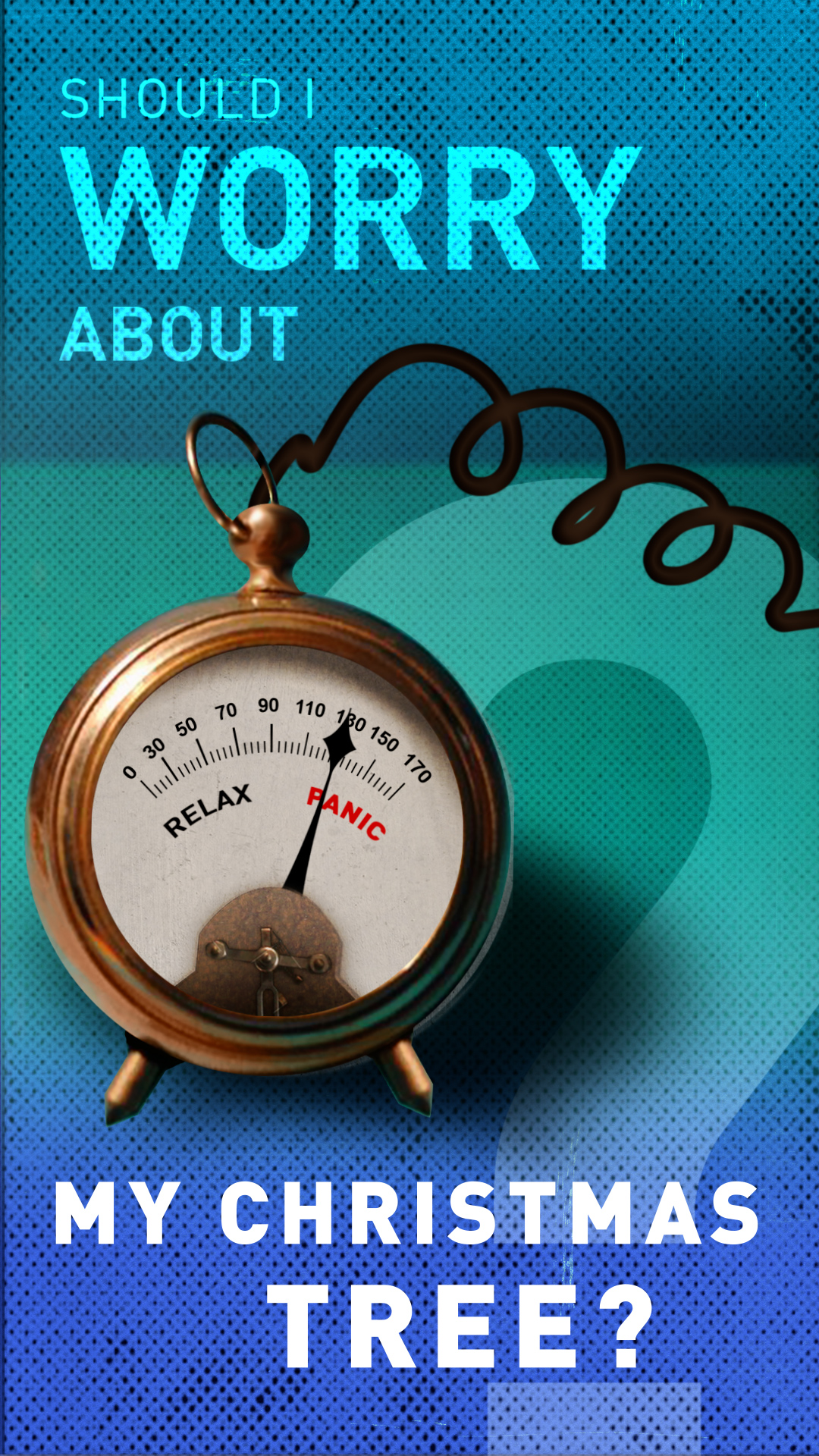
By early December, it's beginning to look a lot like Christmas across Europe, even with lockdowns, COVID-19 restrictions and with family get-togethers being in doubt in several nations.
For many families, the approach of the festive season means it's time to get lights, wreaths and garlands out of the boxes in the basement and decorate the traditional Christmas tree to put the presents under.
But as the climate crisis becomes ever more urgent and a more widely discussed topic, the choice of exactly what type of tree to set up - fake or real - is a hot topic.
So, what's the most sustainable choice?
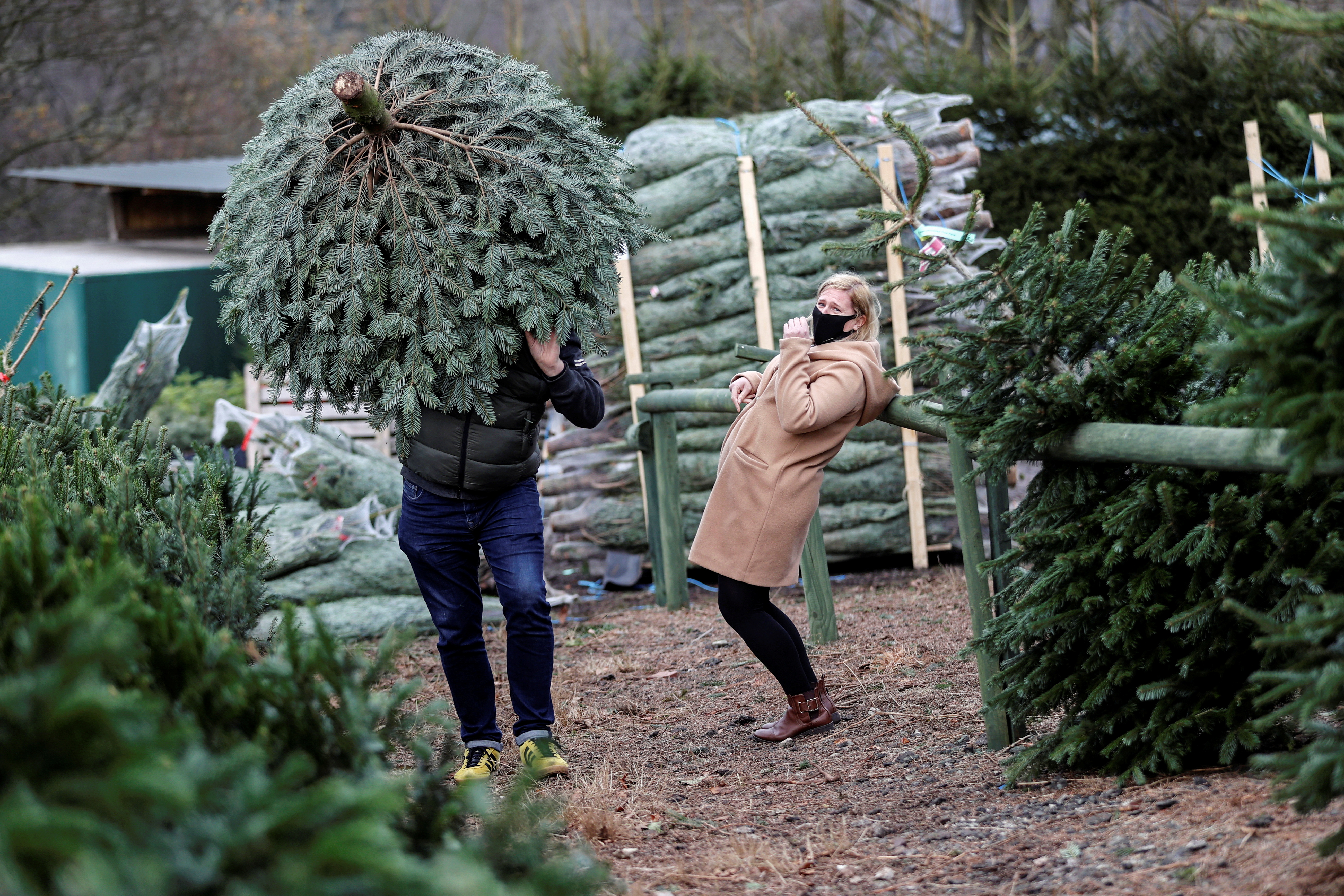
A person carries a tree at a Christmas Tree Farm in Staffordshire, UK. /Carl Recine/Reuters
A person carries a tree at a Christmas Tree Farm in Staffordshire, UK. /Carl Recine/Reuters
What's the problem?
Christmas is Europe's traditional winter holiday season, with gifts, plenty of food and family get-togethers. But it's also the time when leave their biggest daily carbon footprint (without taking flying into account).
It's a combination of higher energy use, food waste, traveling around to meet friends and family and buying a quantity of presents that many would argue is often excessive.
Christmas trees aren't top of the list of "culprits" for these higher CO2 emissions, but as every little action counts in fighting the climate crisis, it's important to consider their cost to the environment.
Natural vs plastic
Every year, Europeans buy up to 150m trees, 40m of which are artificial, while the rest are all natural, whether that means free (25m) or commercial (80m) trees.
The biggest producer is Germany, the heartland of the Christmas tree tradition, with 15m trees, followed by Denmark, Europe's biggest exporter and producer of 12m trees.
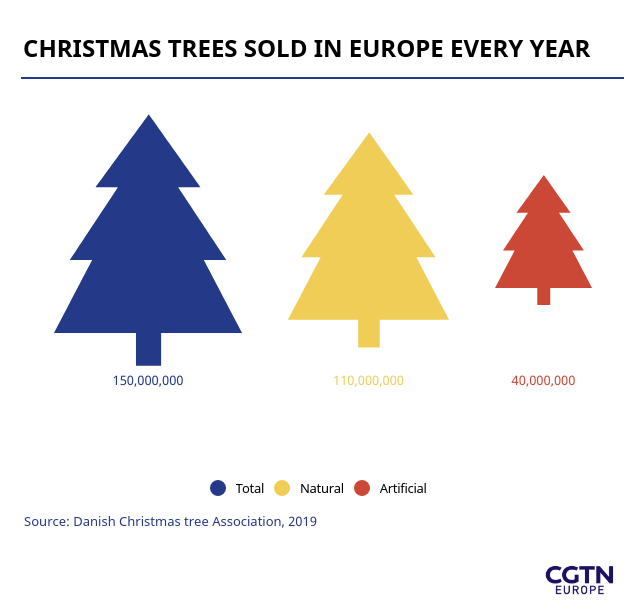
Across the continent, 120,000 hectares of land are used to cultivate traditional Christmas trees such as the Nordmann fir, the so-called "king of the trees," the Blue spruce, the Noble fir, the Norway spruce and pines.
The trees are normally cultivated in farms in cycles of 10 years, after which they're cut down and sold as Christmas trees. Very few of the Christmas trees sold in the run up to the holidays actually come from forests.
According to Claus Jerram Christensen, director at the Danish Christmas Tree Association: "Eighty percent of the Christmas trees are cultivated on former farmland, so there's only 10 to 20 percent which are grown in the forest."
Most of the seeds used to cultivate Christmas trees in Europe are imported from Georgia, by the Black Sea. The seeds are then transferred to a nursery where the trees stay until they grow into small plants – a process that takes three to four years. After that, the trees are transplanted into the field for another eight to 10 years.
The amount of resources that go into growing a natural Christmas tree might appear very wasteful, but experts agree that natural trees are overall more sustainable than plastic Christmas trees.
Research by the UK-based Carbon Trust shows a natural tree that ends up being chipped or burnt as firewood has a 3.5 kg CO2 carbon footprint, while if it is disposed of in a landfill, where it goes on to naturally decompose, its footprint goes up to 16 kg.
"Obviously opting for real trees is definitely seen as a better option from a sustainability perspective," says Sabrina Parker from Carbon Trust.
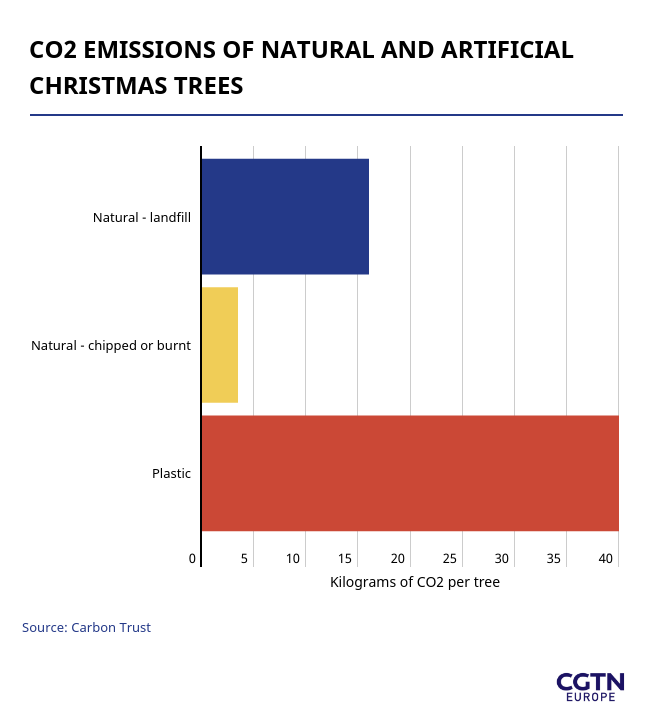
"But if that tree ends up in a landfill, then it's just going to decompose – and that will emit quite a lot of methane, which is quite a potent greenhouse gas.
"If we looked at the end of life for a real tree and we opted for recycling it over putting it in the landfill, then the impact would be considerably lower," she says.
On the other side, the carbon footprint of a plastic tree can reach up to 40 kg of CO2, most of which comes from manufacturing. Artificial Christmas trees are made from oil and are often PVC, a type of plastic that’s very hard to recycle. Moreover, international shipping of the trees – often made in China – adds up to their carbon emissions.
"If there's metal in there, then it's probably got a higher footprint," says Parker.
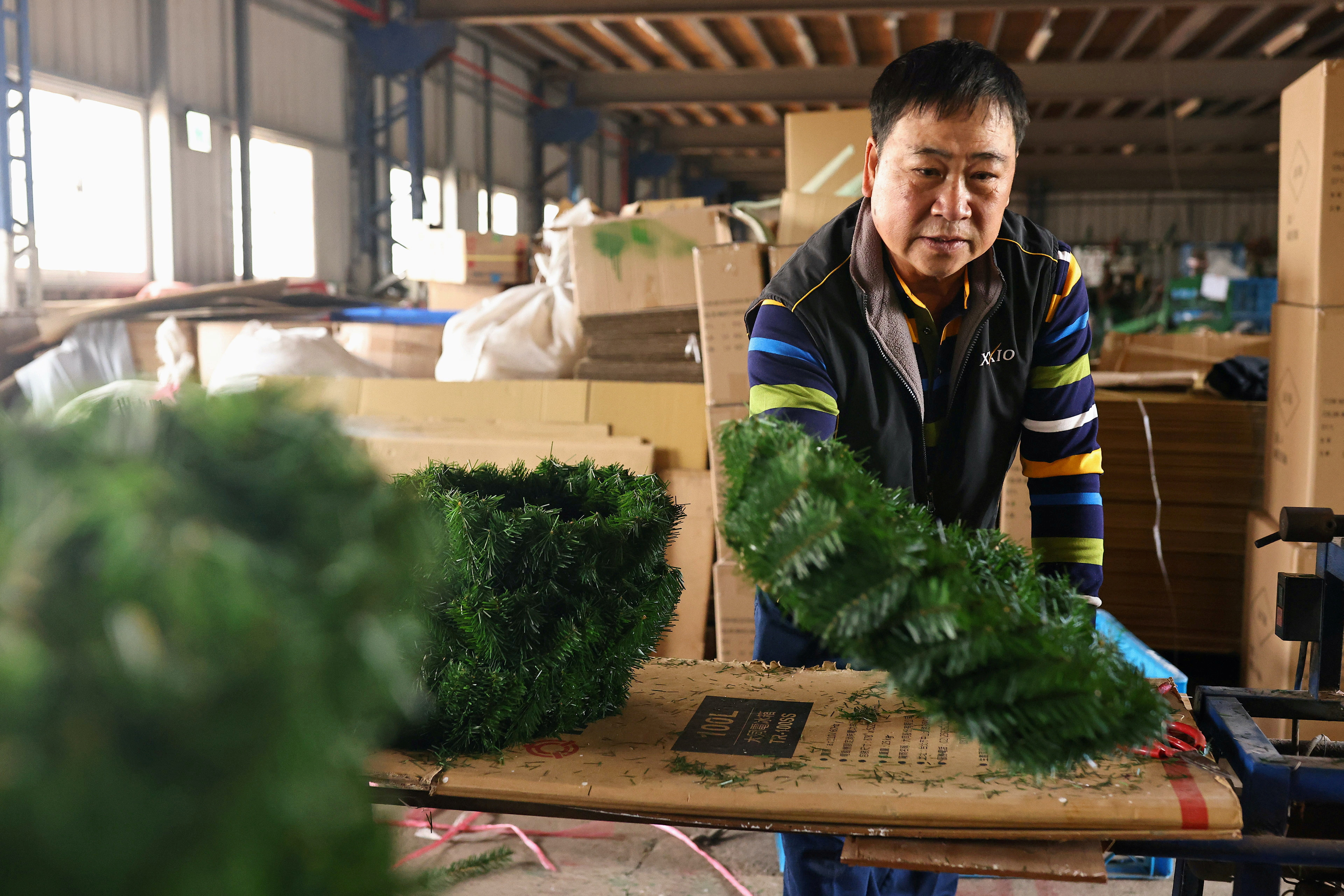
An employee makes Christmas tree branches at the factory of Lien Teng Enterprise in Taiwan, China. /Ann Wang/File Photo/Reuters
An employee makes Christmas tree branches at the factory of Lien Teng Enterprise in Taiwan, China. /Ann Wang/File Photo/Reuters
Despite the fact that plastic trees can be less "wasteful" than real ones, you would need to use your artificial tree for 10 to 12 years for its environmental impact to be lower than that of a real tree.
"If we're looking at it over a longer period and it's being taken care of and being used for a very long time, probably more than 10 years, then it would have a lower environmental impact than buying a commercially grown tree every single year," explains Parker.
Also in favor of natural Christmas trees is their positive impact on the environment – the trees absorb CO2 and continue to do so even in our homes. Also, they offer a habitat for the local wildlife for at least the 10 years they're cultivated before being chopped down and sold for the festive season.
One other factor to consider for both real and artificial trees is transport. Experts suggest buying local where possible to cut down on CO2 emissions, but even that must be weighed against other factors.
"It doesn't matter as much as you think," says Christensen, defending Denmark's heavy exporting of Christmas trees abroad.
"So, in Europe, for instance, [transport] is mainly by truck. If you can have some thousand trees on a truck, that's very much, we say, energy-effective compared with when you take your car and drive, for instance, 20 km to get a local tree."

What do the experts say?
The verdict is in – natural Christmas trees are more sustainable than plastic ones, according to experts... unless you buy and use the same artificial Christmas tree for at least 10 years.
But those of us who have picked a natural Christmas tree this year should not feel off the hook entirely. The most important factor in ensuring the sustainability of a natural Christmas tree is to ensure it is disposed of properly.
"Looking at some countries and the UK being one of them, there are local authorities that actually collect and offer a kind of Christmas tree collection service," says Parker.
"So they'll shred it down for you, and that will then be spread into gardens, put into parks. It is a way to improve the quality of the soil, which is kind of an additional environmental benefit from a carbon perspective."
There are also other more exotic and unusual ways of recycling Christmas trees: "Elephants and goats in zoos, they love to eat and play with Christmas trees," says Christensen.
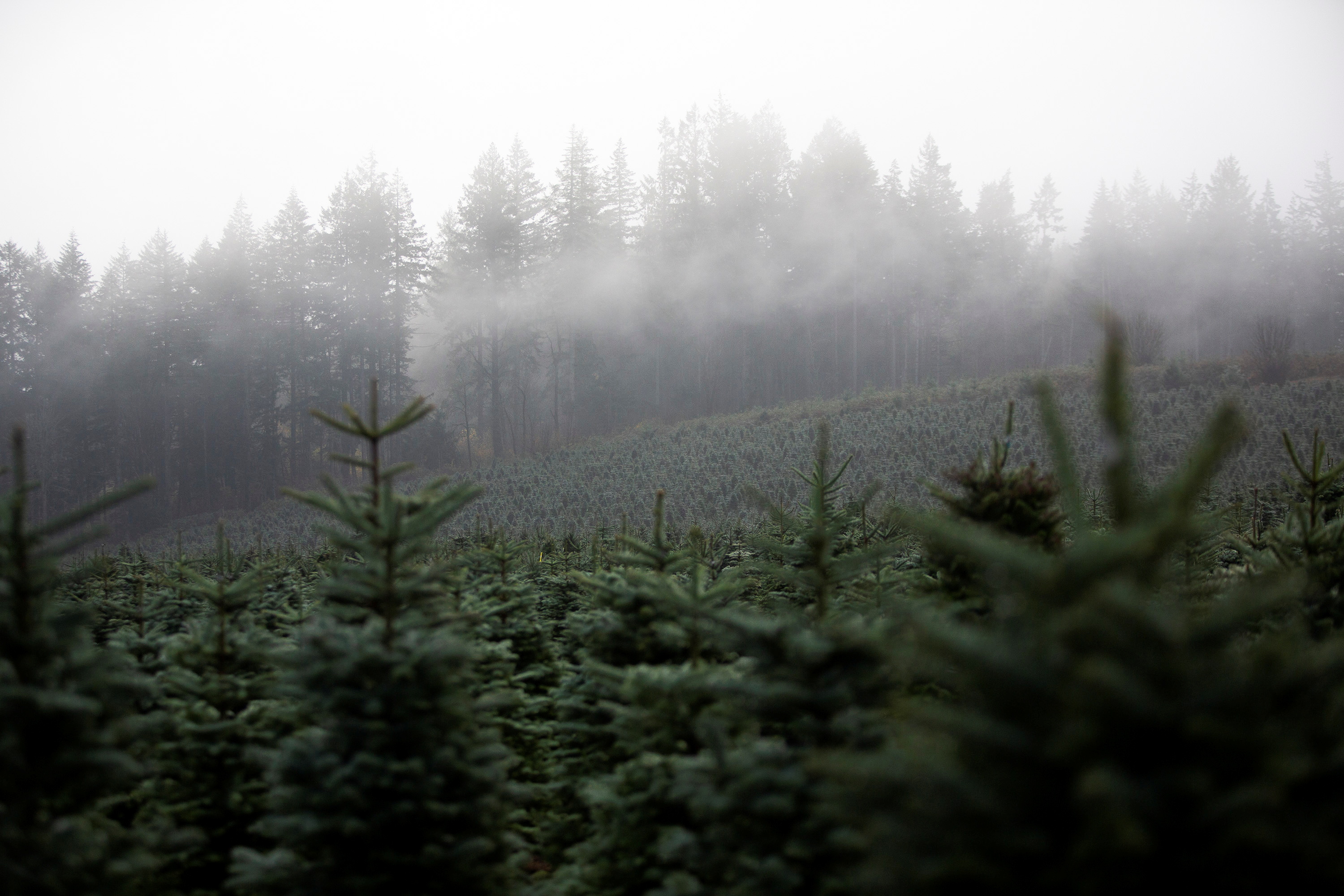
The use of Christmas trees spread from Germany in the 17th century and the country remains Europe's largest producer of Christmas trees. /Alisha Jucevic/Reuters
The use of Christmas trees spread from Germany in the 17th century and the country remains Europe's largest producer of Christmas trees. /Alisha Jucevic/Reuters
There is also another issue related to getting a real Christmas tree. Even the families most attached to the tradition of choosing the perfect tree for their home may feel guilty about cutting down a perfectly healthy, living tree for a few weeks of decoration.
But experts say feeling bad about a Christmas tree is pretty much the same as feeling bad for a lettuce. "Christmas trees are grown in plantations and they are not meant to be big trees in forests," says Christensen.
If you still can't bring yourself to have a chopped-down tree at home, consider a tree rental service. These companies offer a pot-grown Christmas tree that you can bring home and return by the end of the festive season, and reorder the year after.
And equally importantly, once you have chosen your tree, remember to think about eco-friendly decorations. A tip? Steer away from glitters.
Carbon trust interview: Kitty Logan
Video editor: Steve Chappell
Cover image: Gleb Garanich/Reuters

